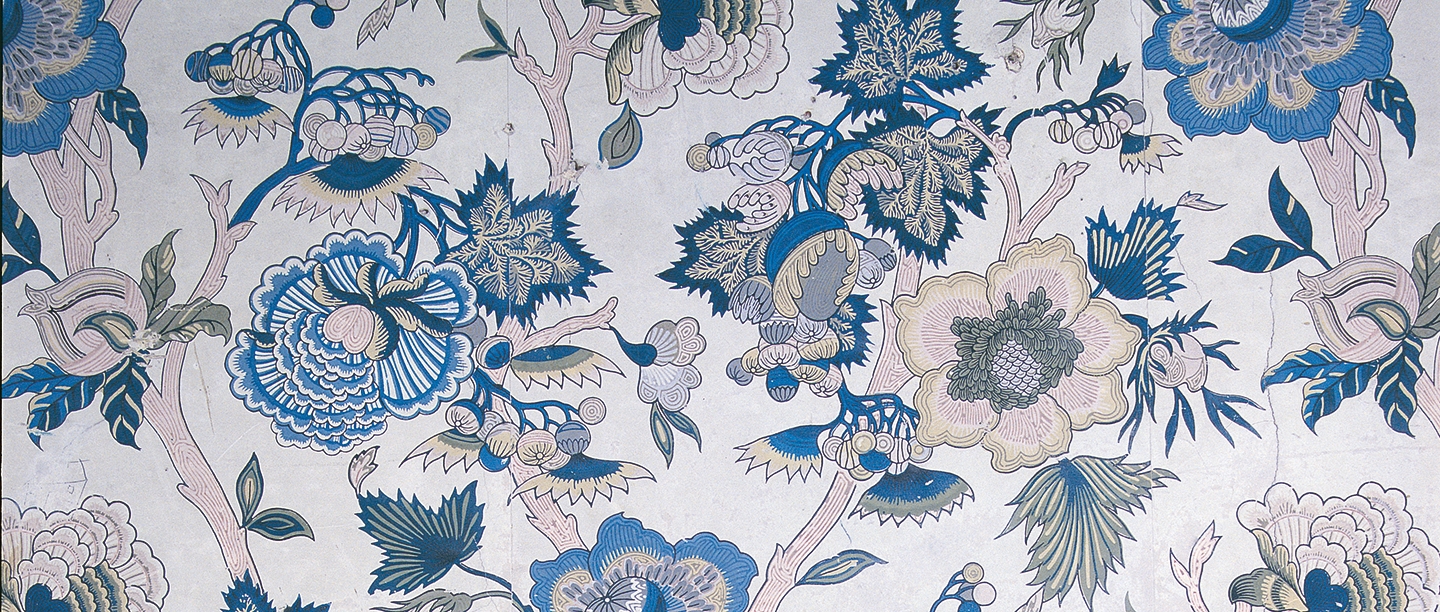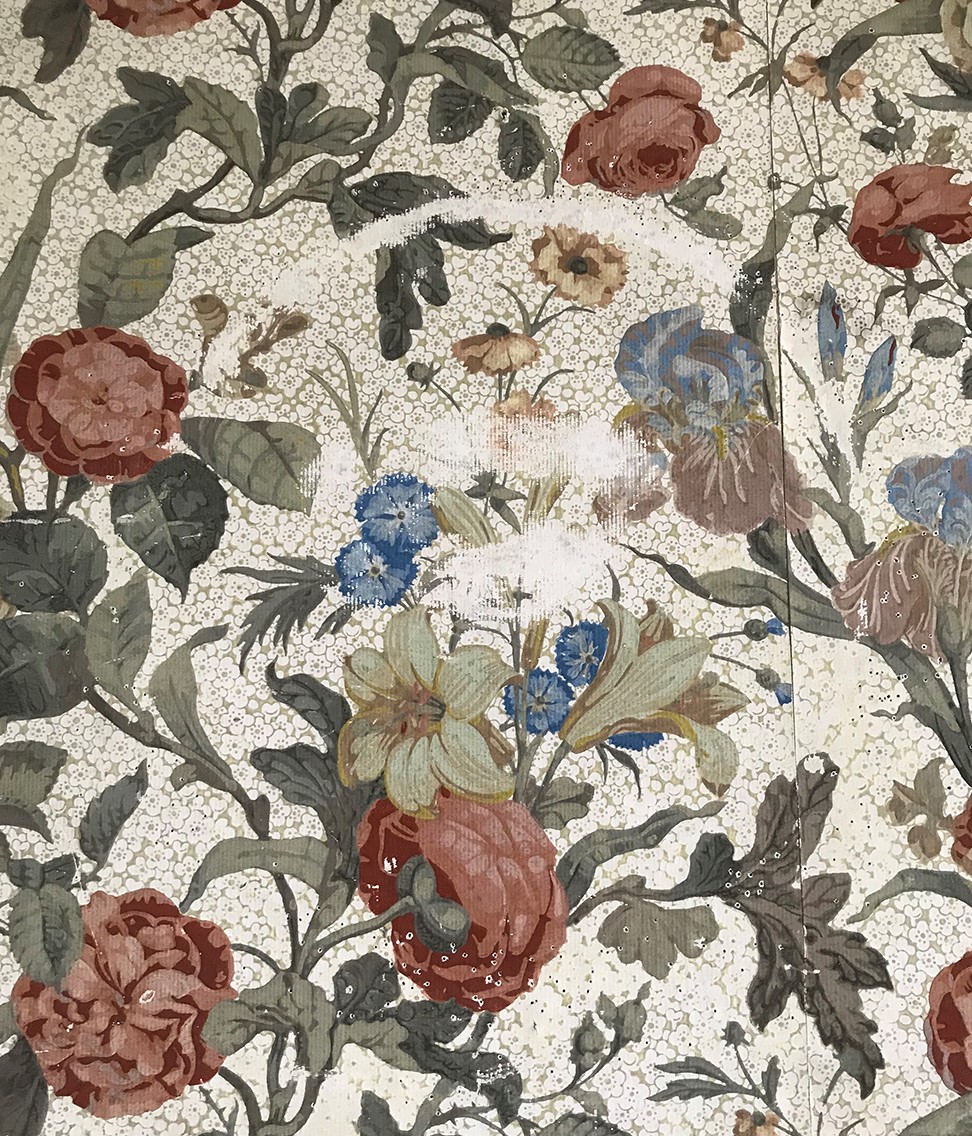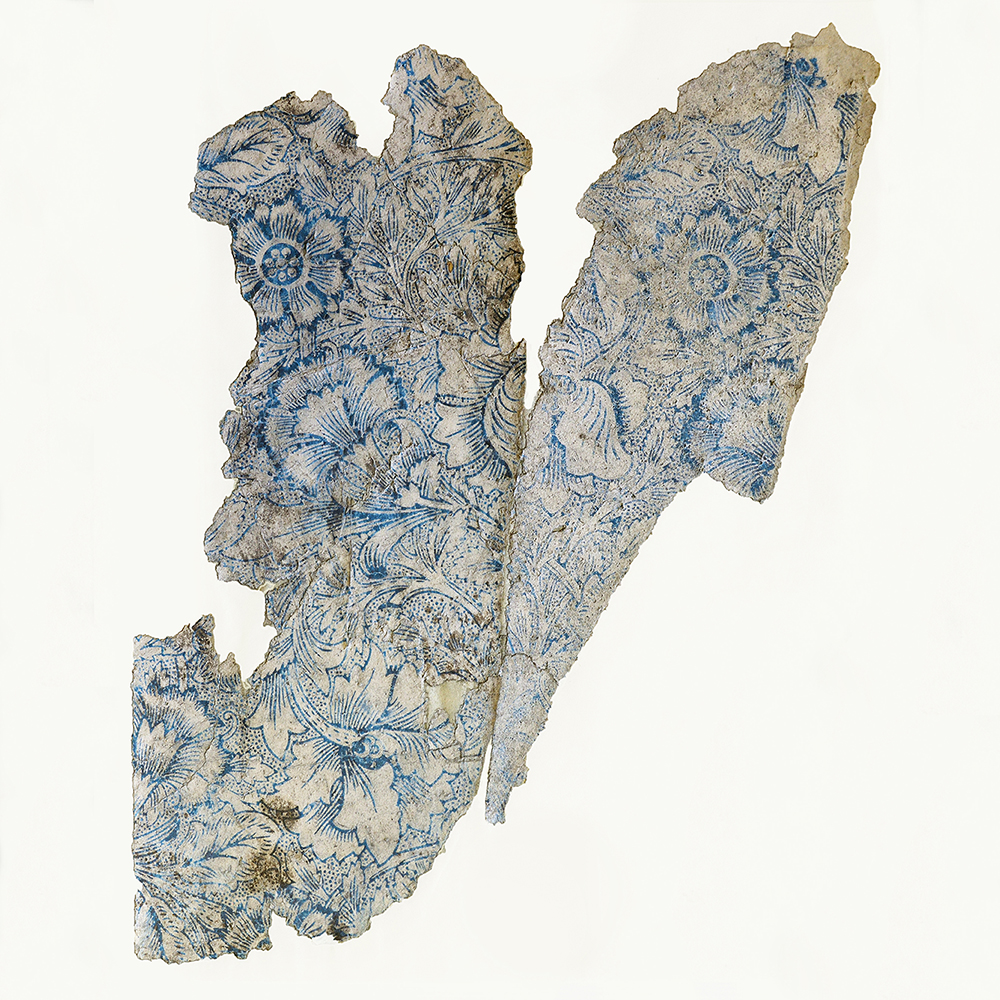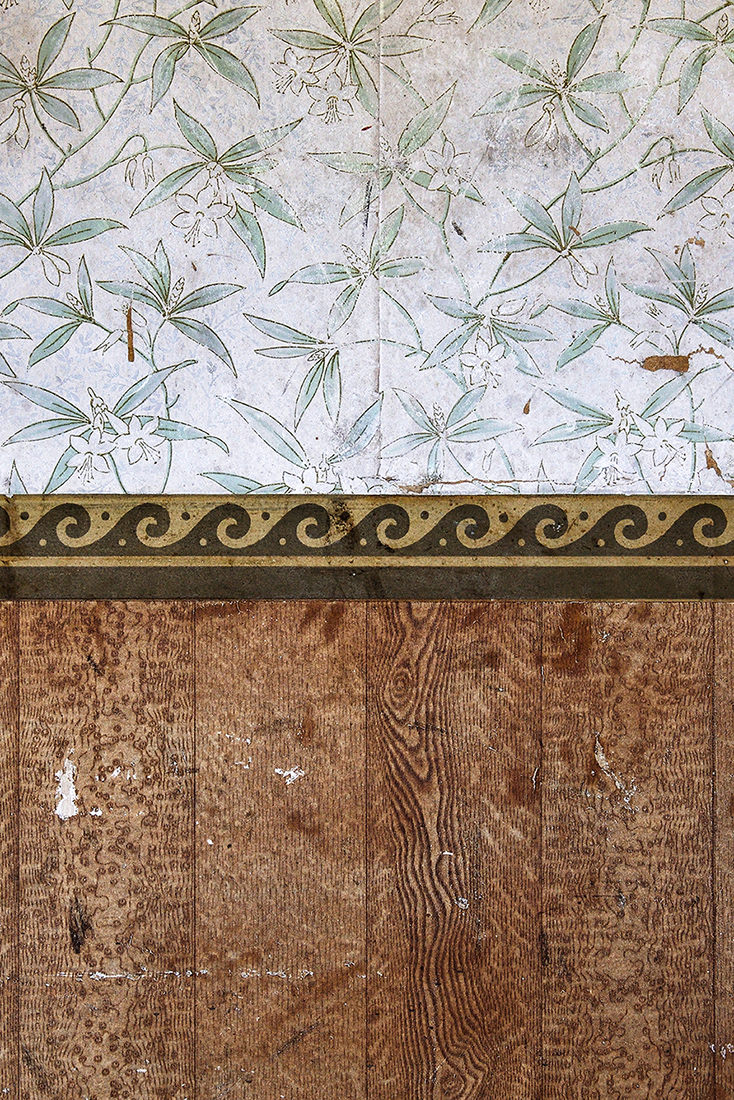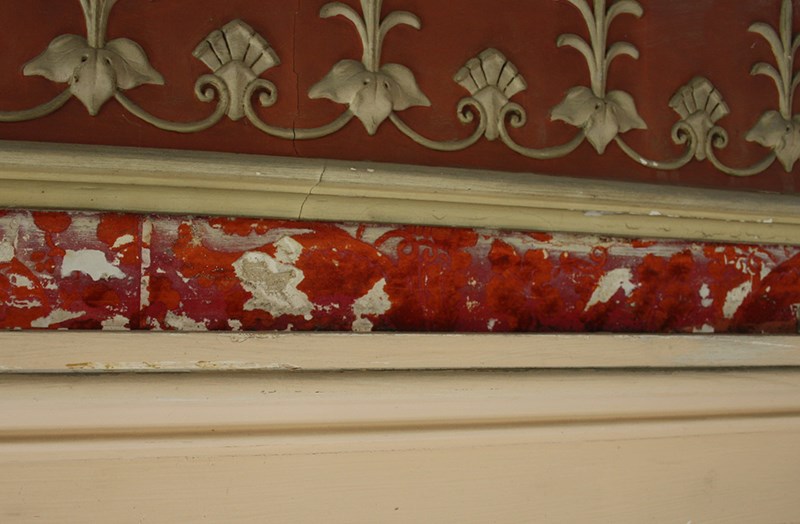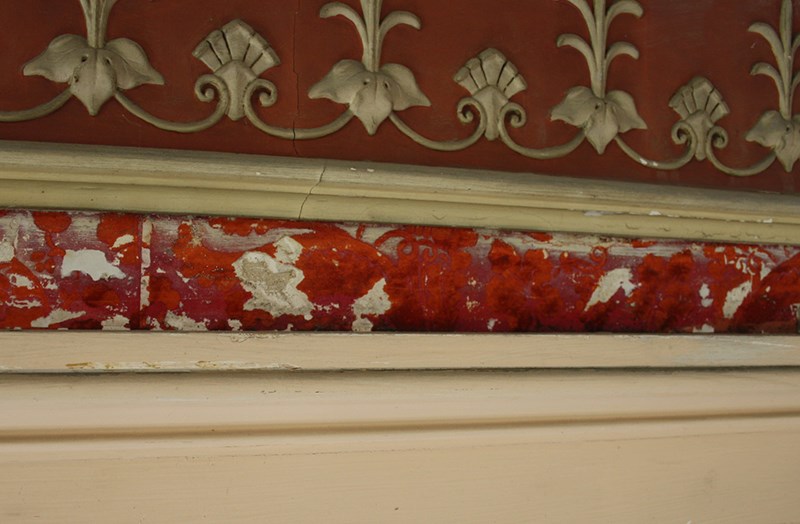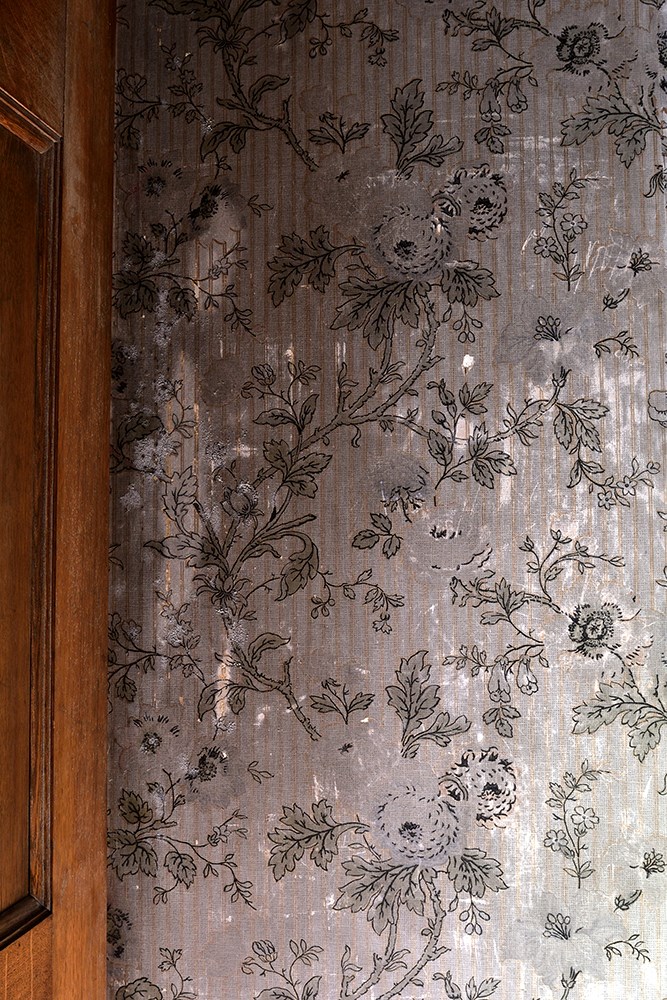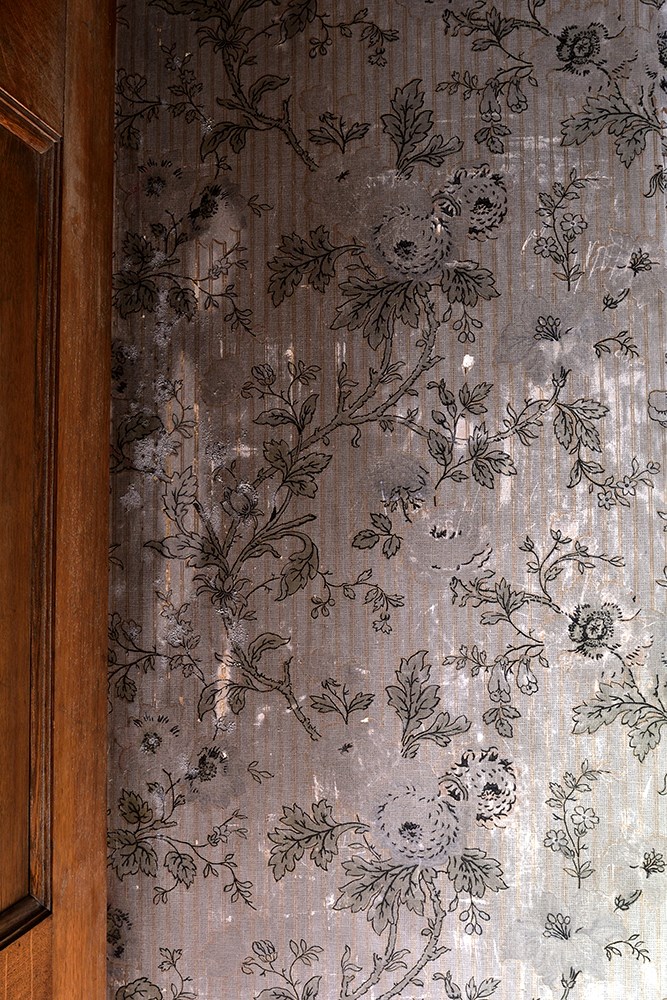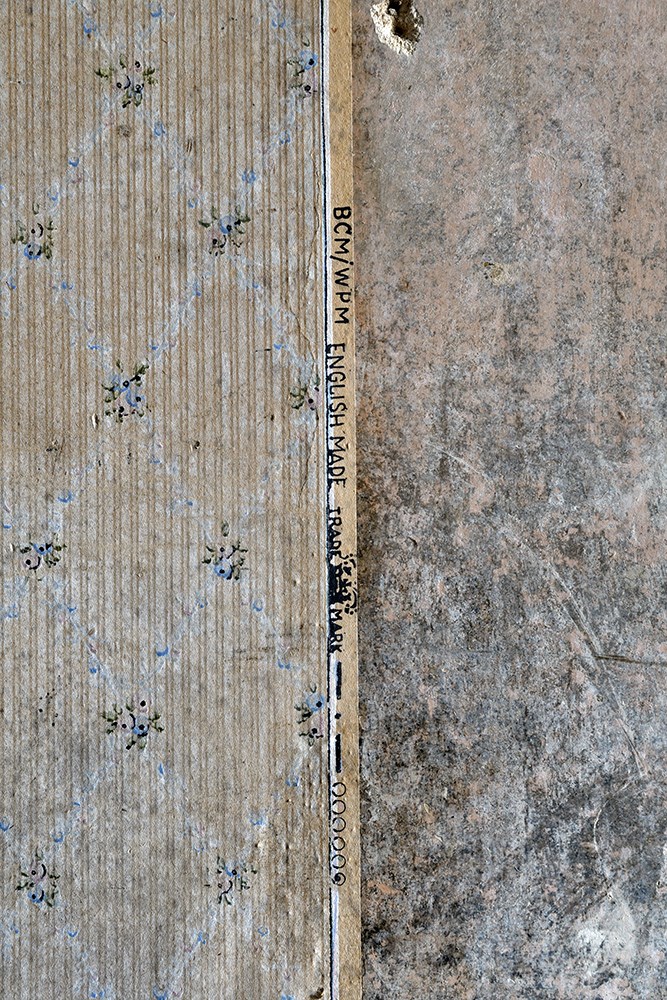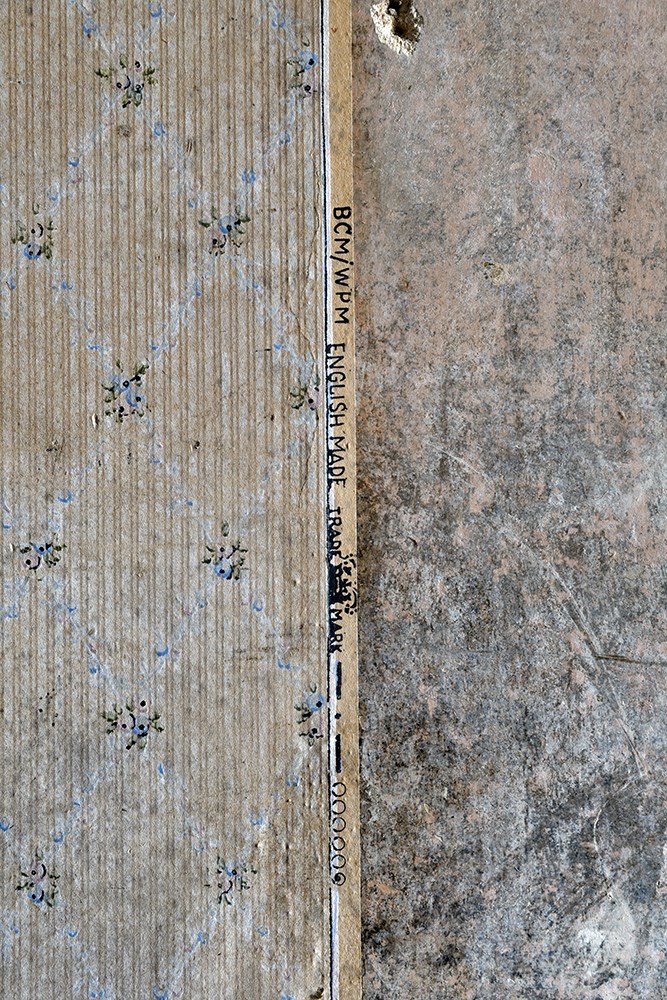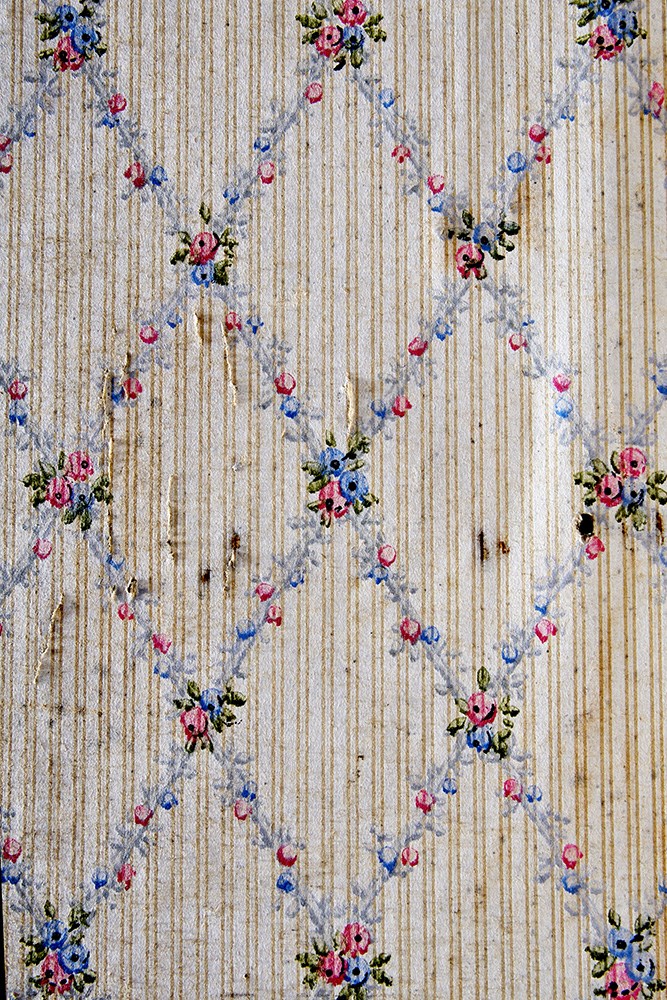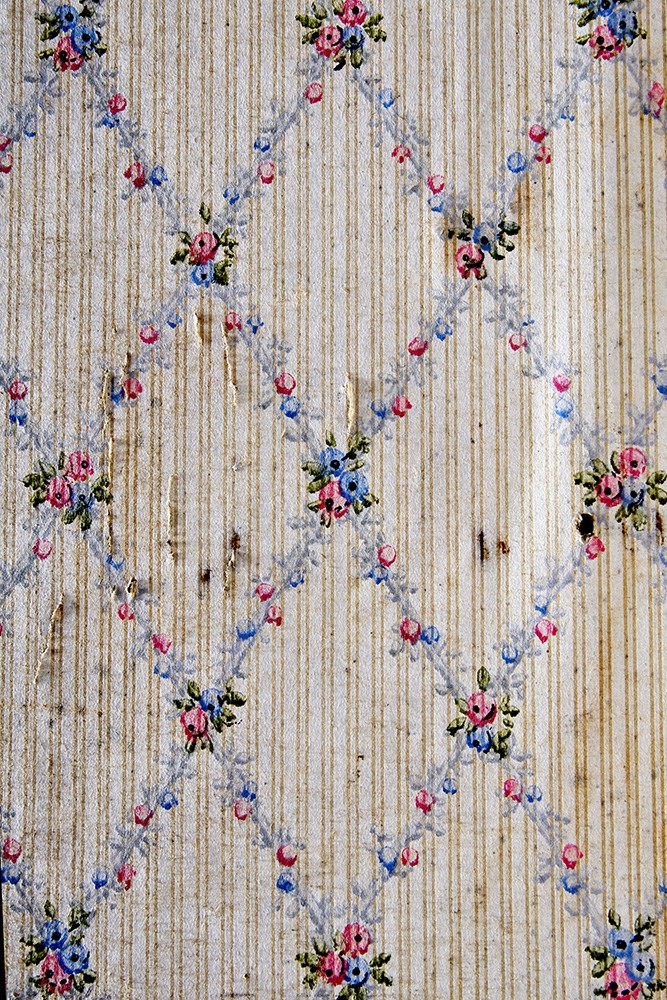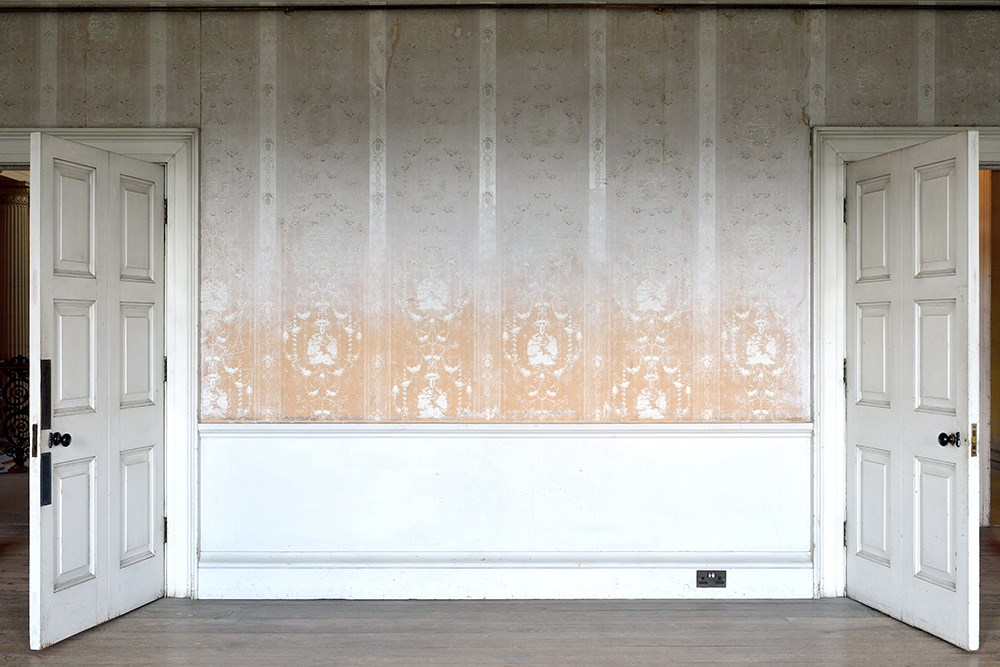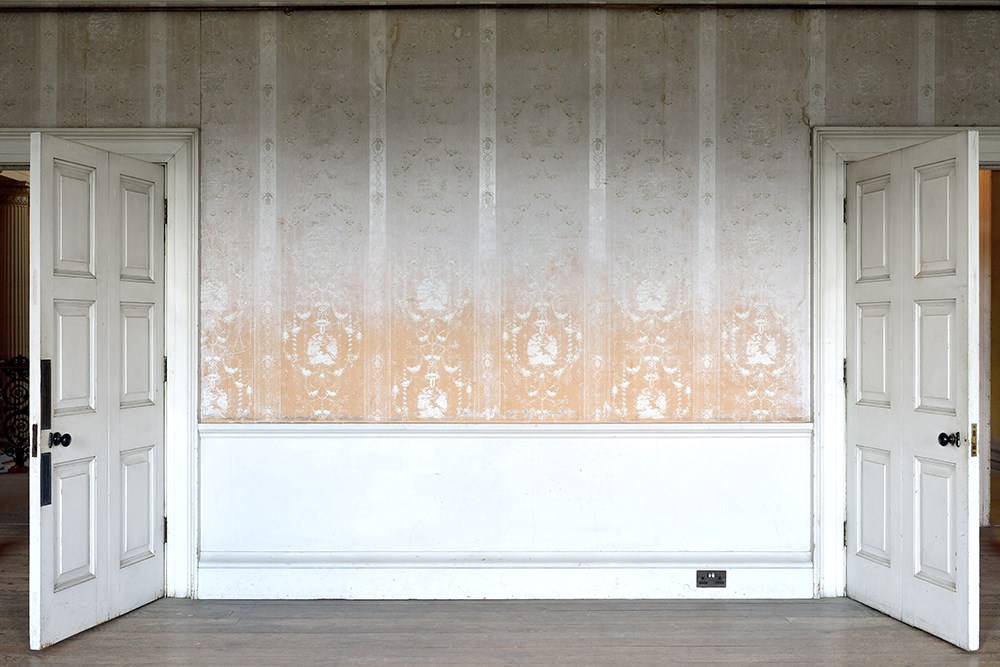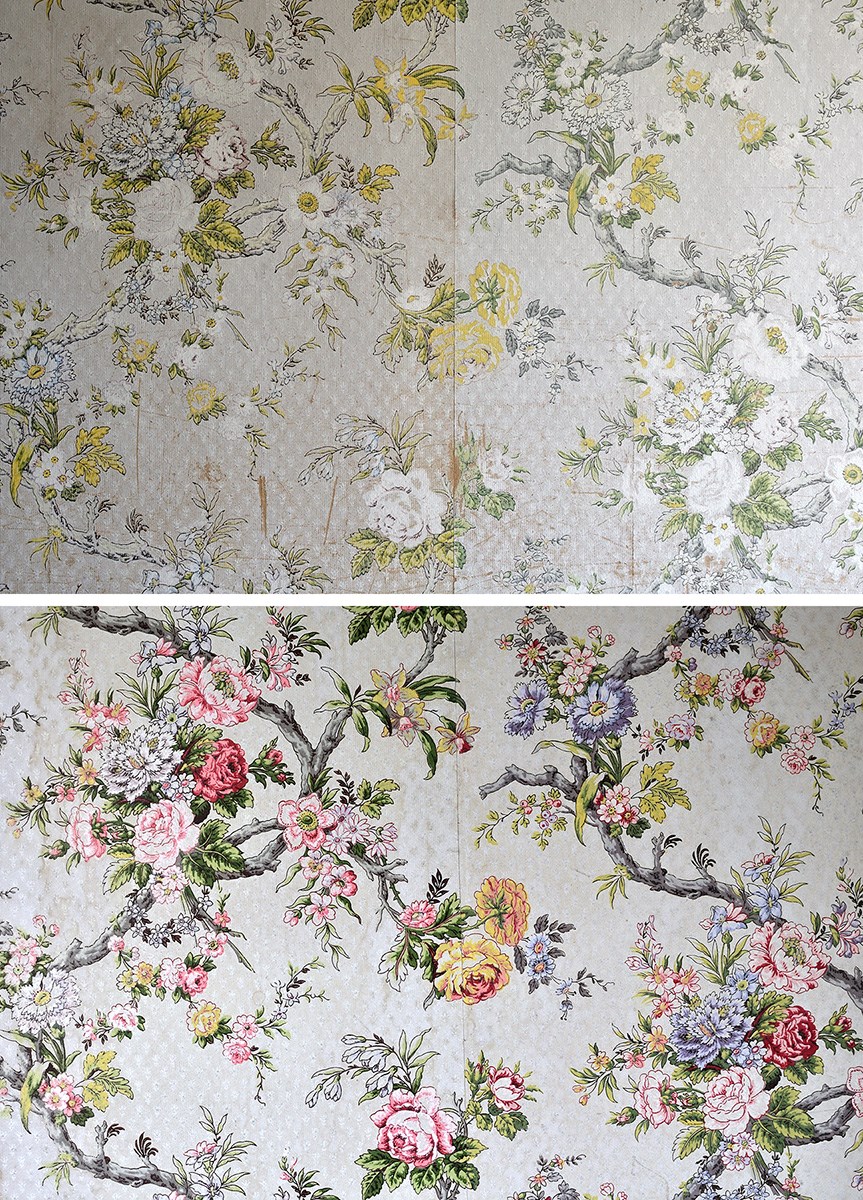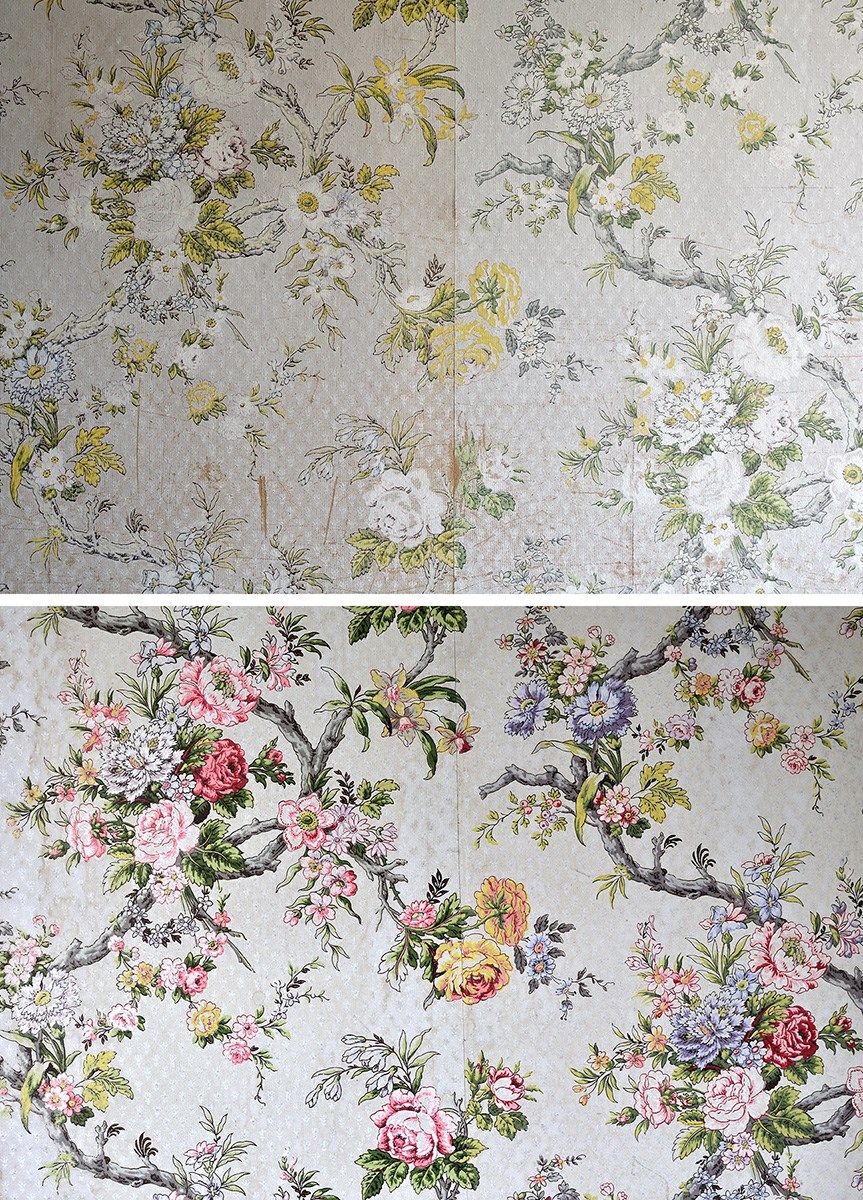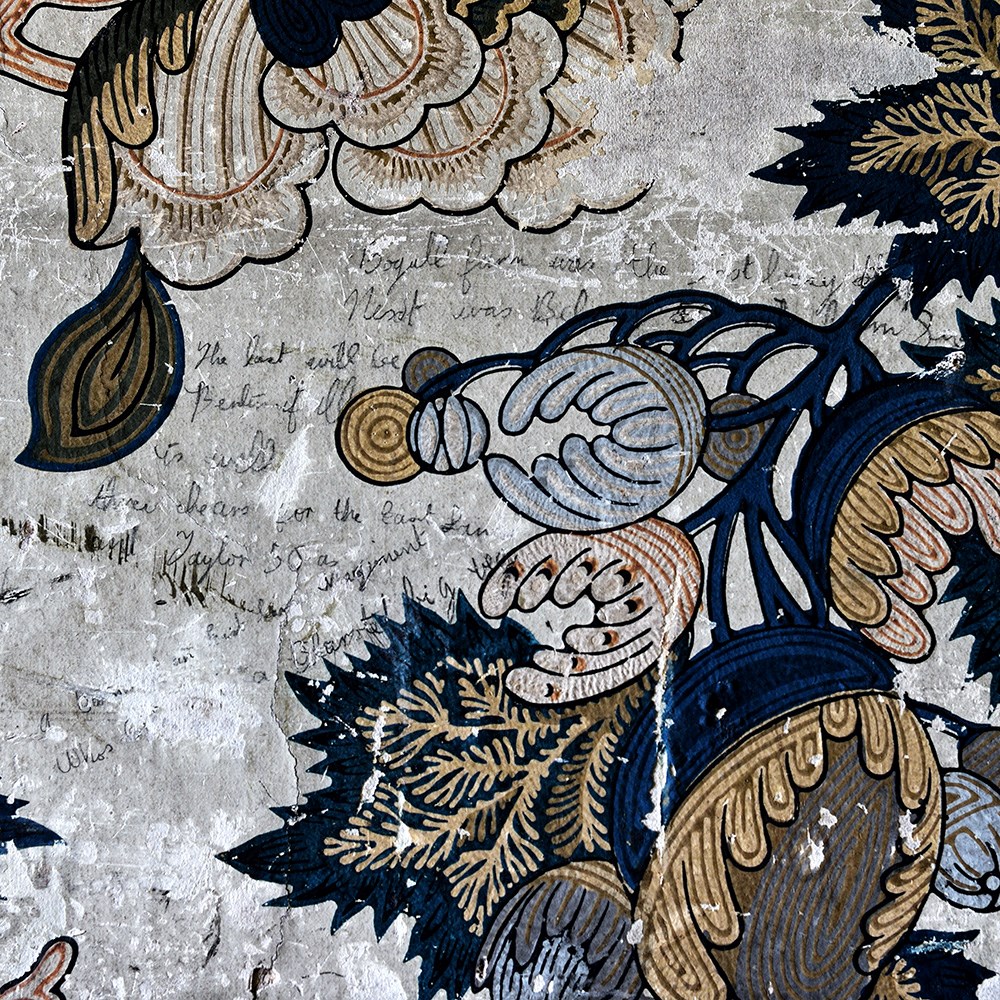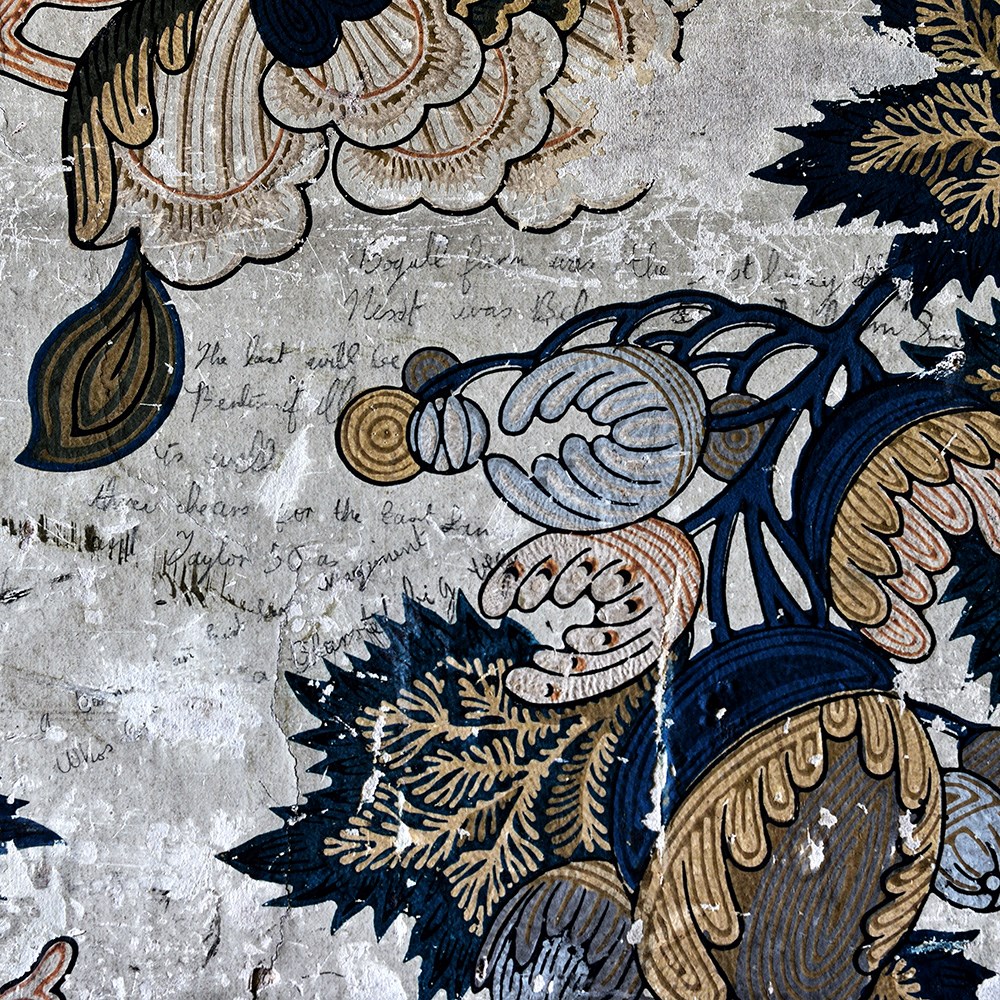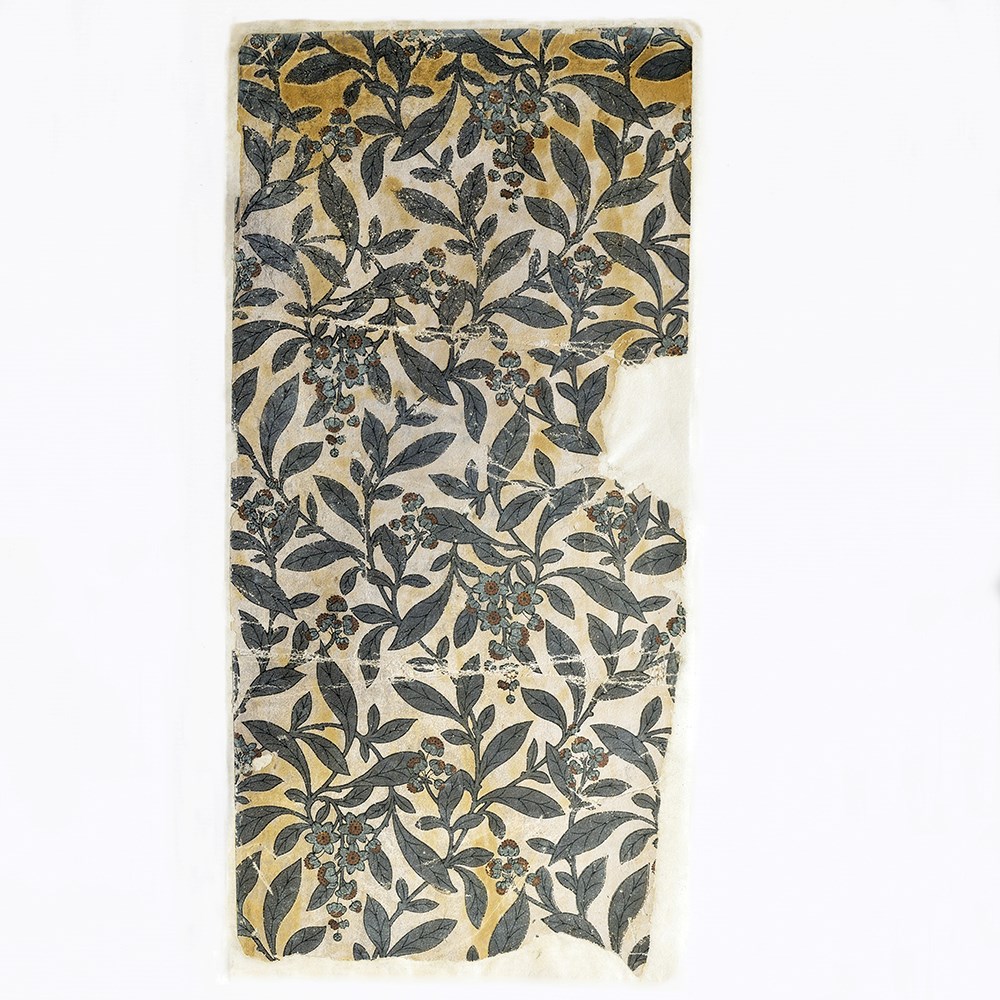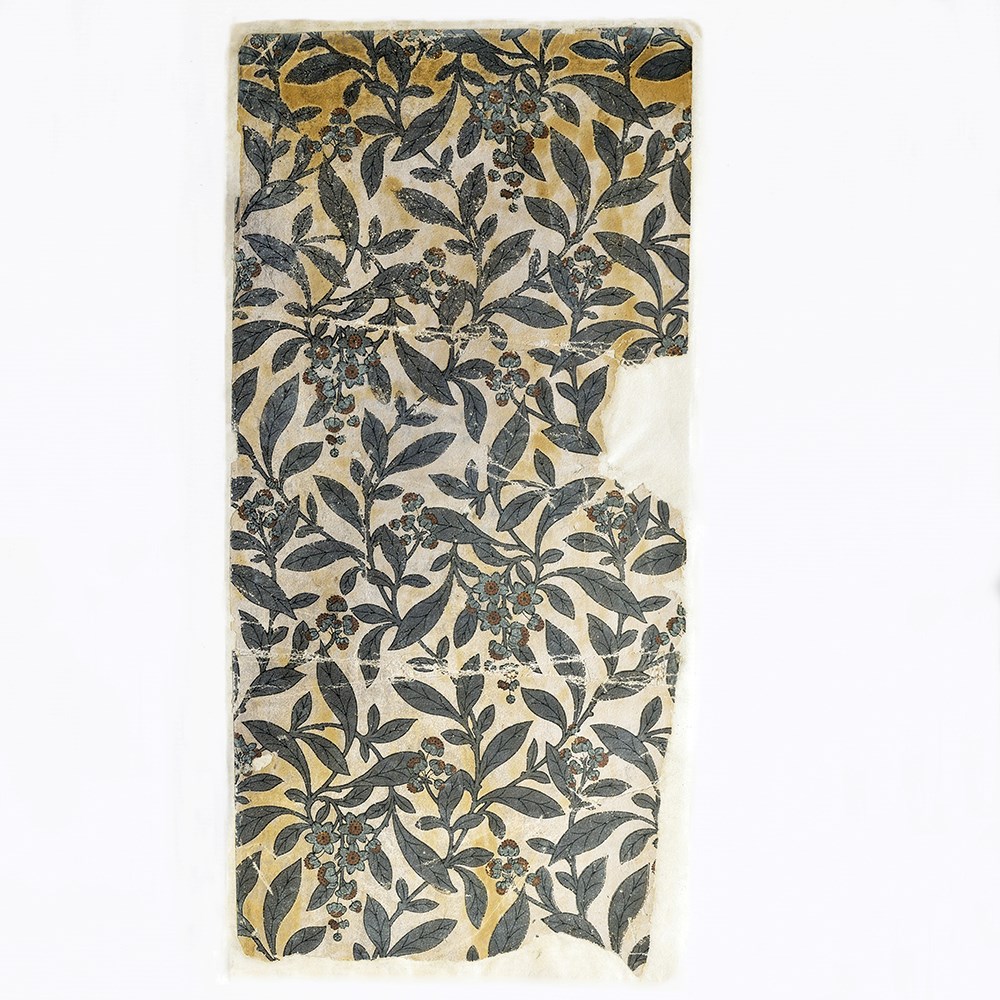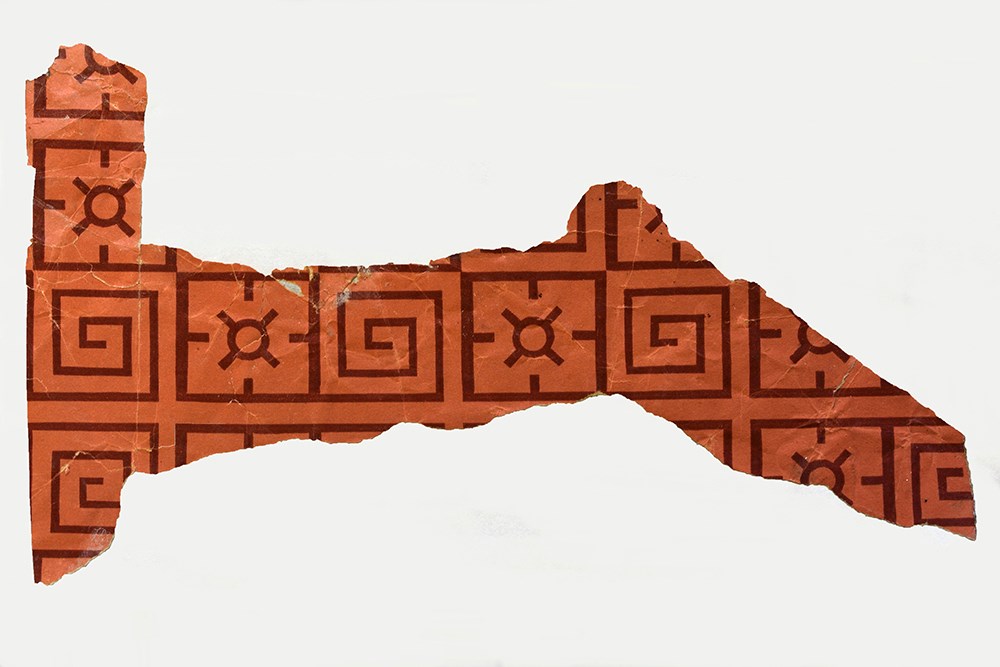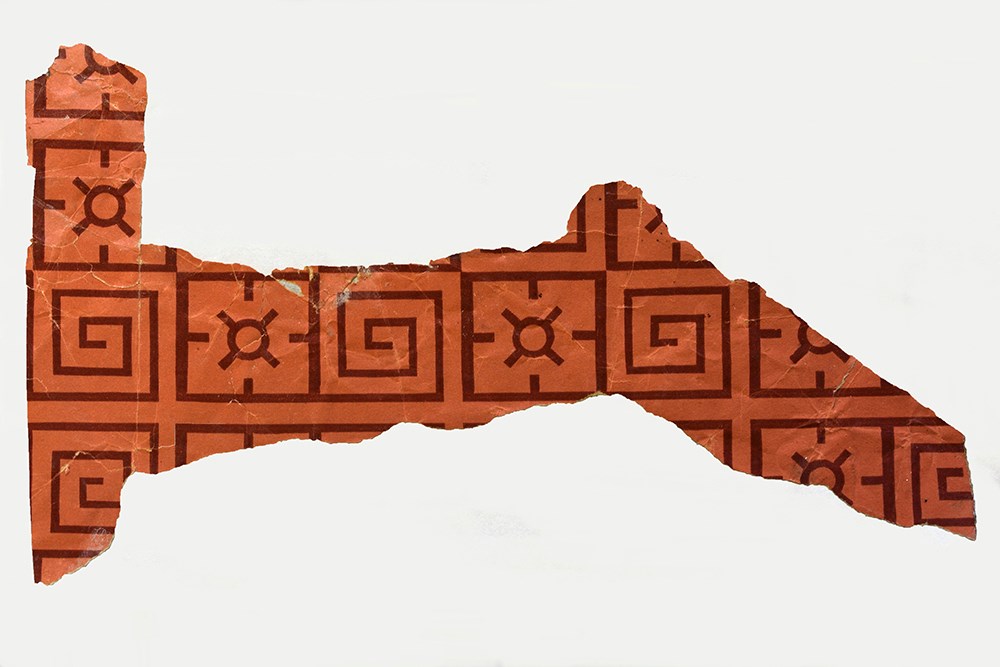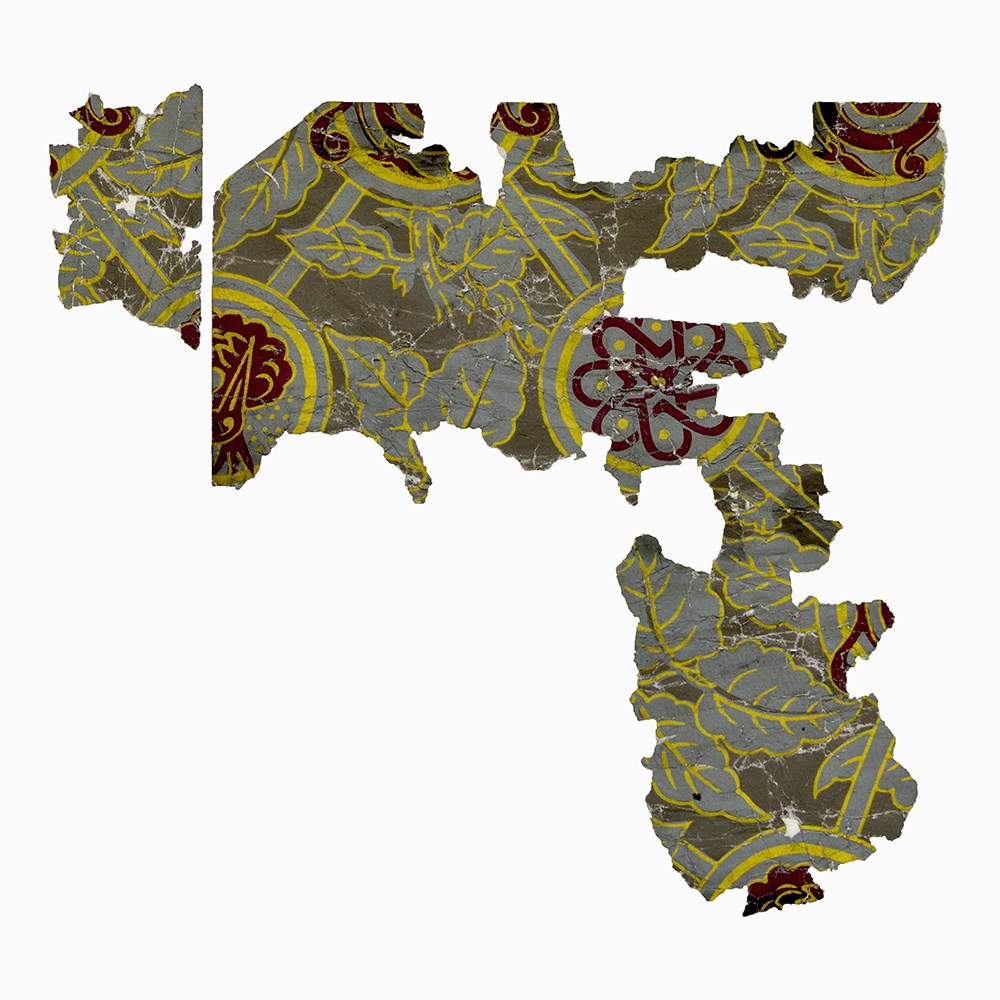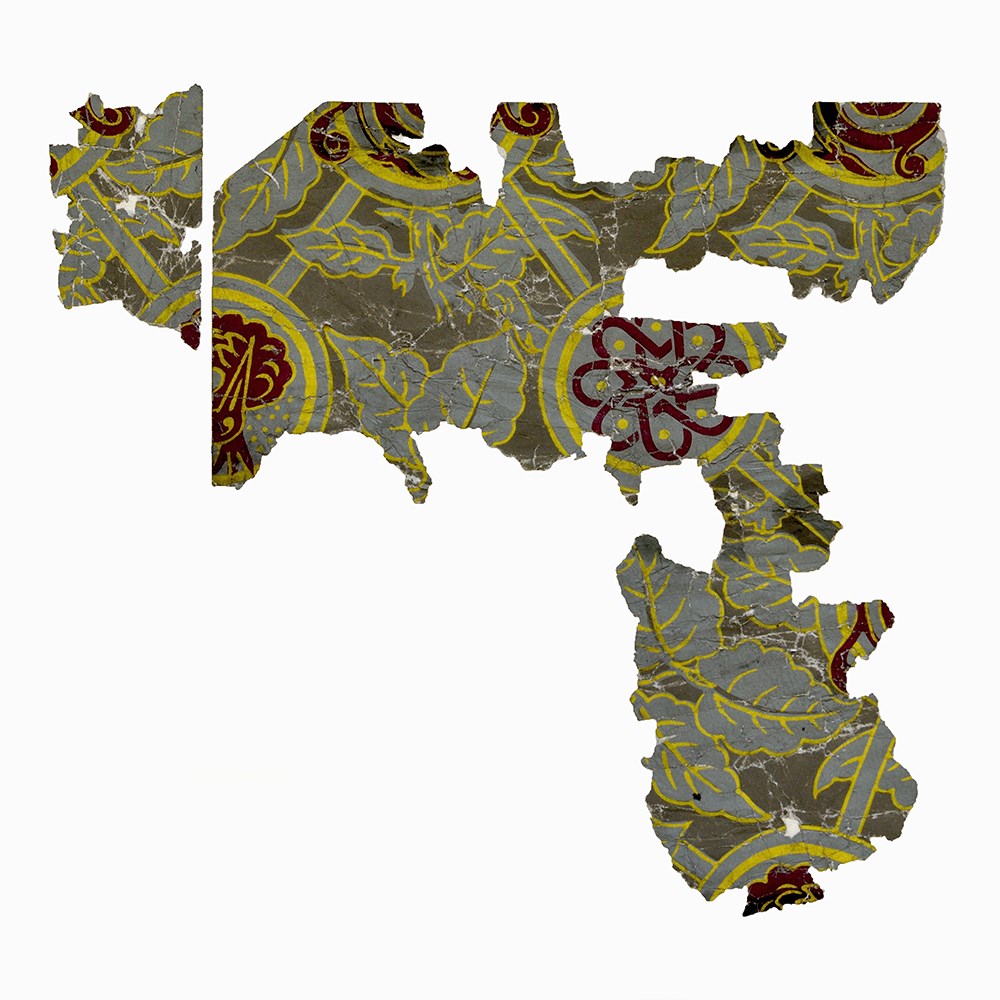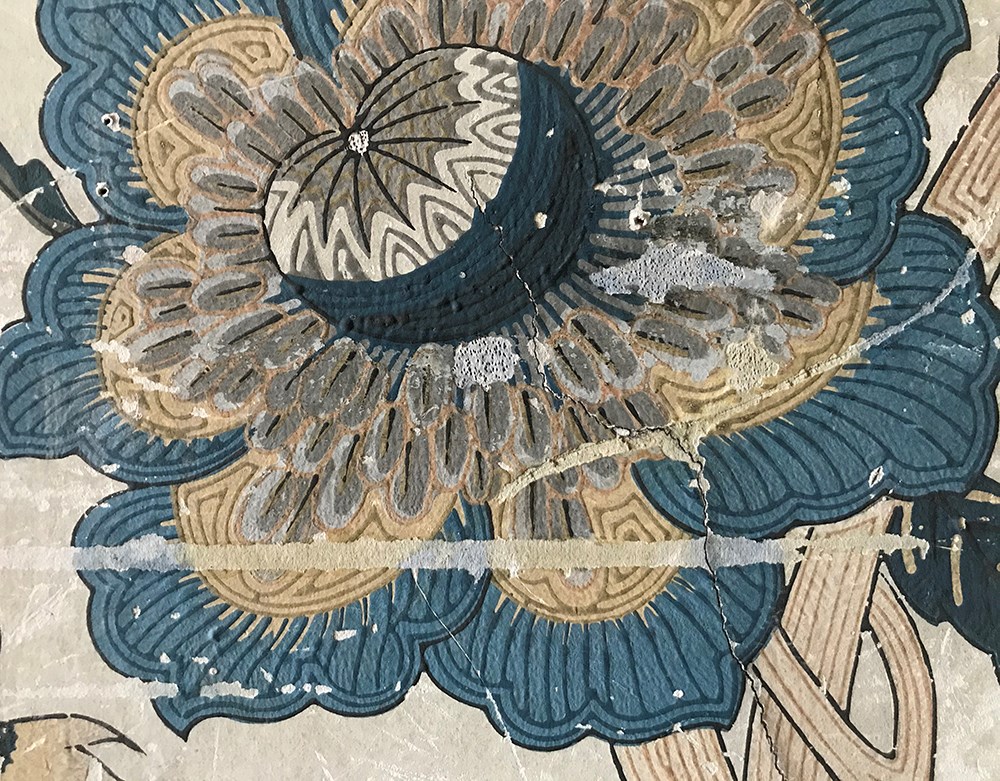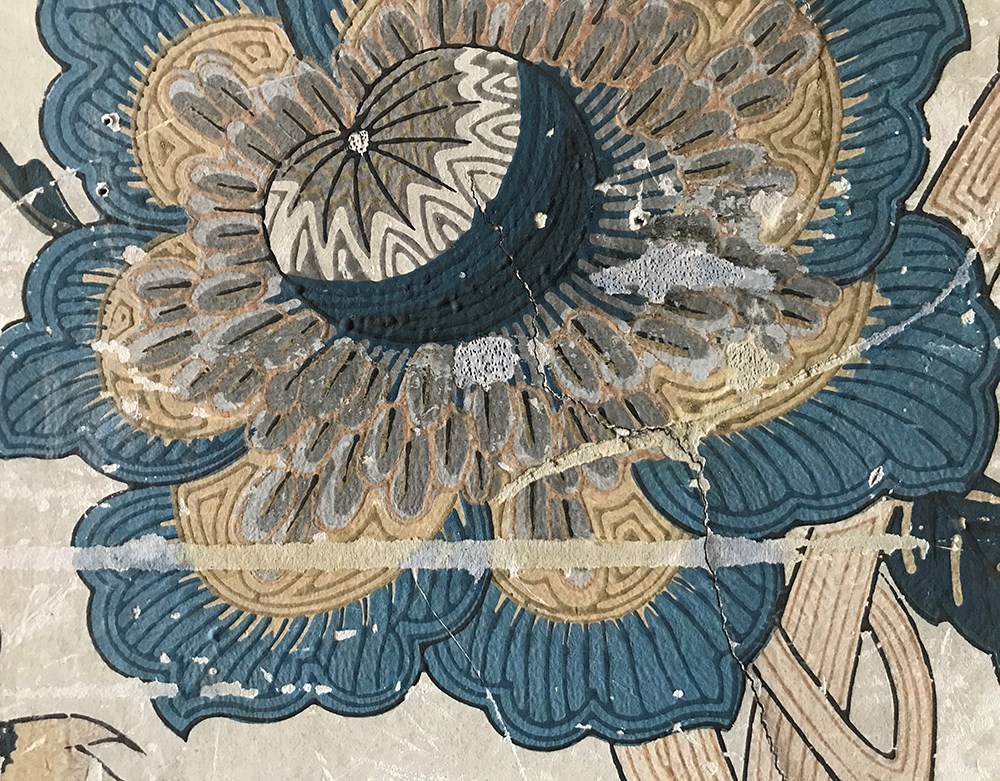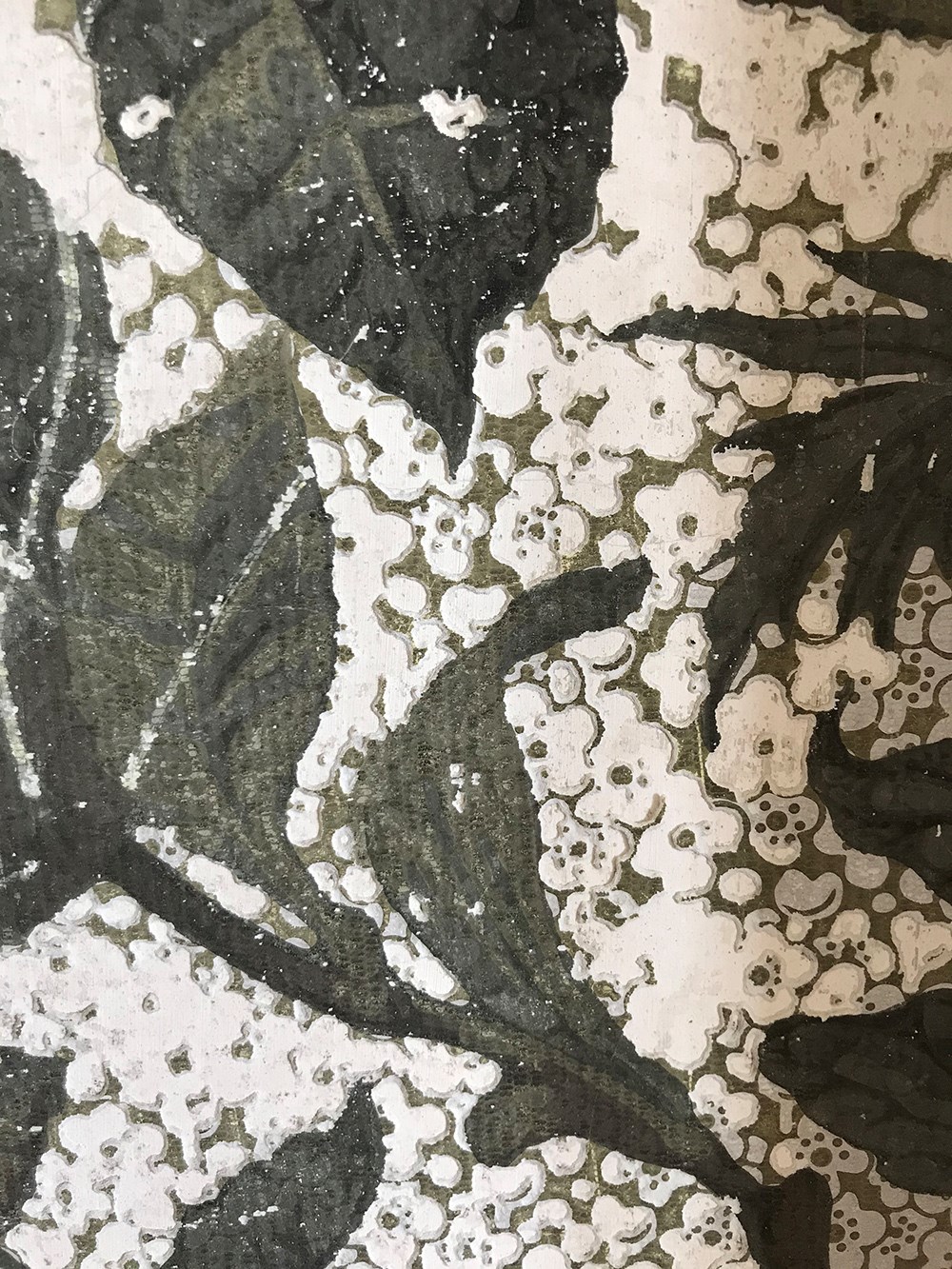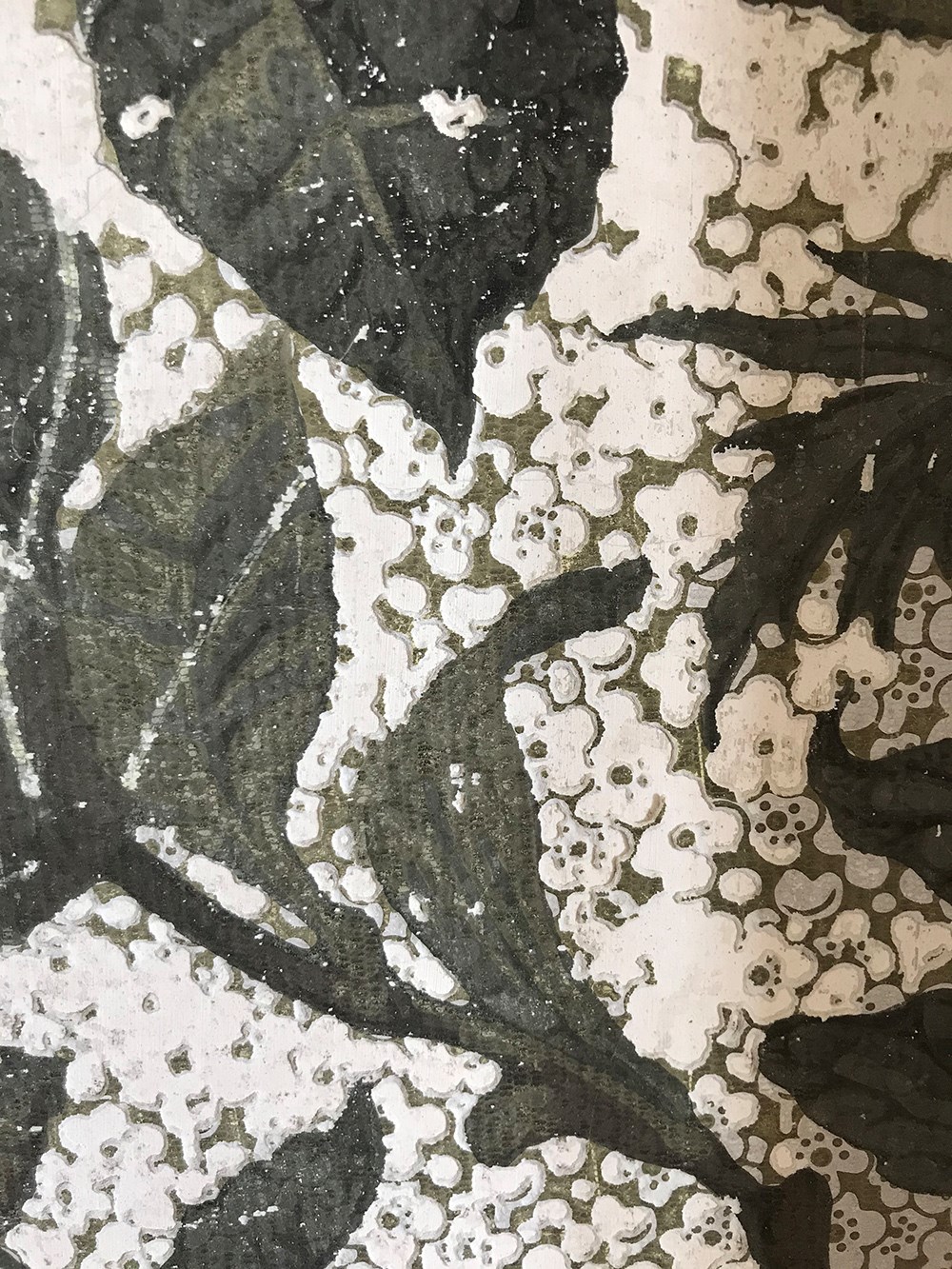Revealing the Layers of History
As part of conservation work on the building’s fabric, English Heritage has surveyed the internal decorative finishes of Belsay Hall. This was first done in 1986, with an investigation of paint schemes, and then in 2016, with a survey of the wallpapers by Dr Philippa Mapes, conservator and wallpaper specialist. Further work has involved carefully lifting sections of the wallpapers and paint to reveal older layers underneath.
Drawing on these investigations, we have recently carried out remedial conservation treatment of the wallpapers, supported by Heritage Lottery funding. We have gently cleaned the wallpaper using soft brushes and sponges. Loose areas and seams of wallpaper – caused by damp environmental conditions, physical damage and pest activity such as silverfish – have been re-adhered. Silverfish had eaten the paste attaching the wallpaper to the walls and damage was particularly focused around the windows. Such areas have been treated with a water-based pesticide.
Fresh surface scratches and small areas of damage have been painted in and toned to match the wallpaper using watercolour pigments. Some sections were able to be washed with distilled water to improve their appearance and in some cases, paper fragments were lined with an internal support of Japanese tissue and either reattached to the wall or placed in archival storage.
This conservation work, alongside the surveys done in the past, has helped us understand the various layers of wallpaper each generation has chosen for the hall. Below you can read more about these layers of history and the different wallpaper schemes we have discovered.
The Anteroom
The original wallpaper in the ground-floor anteroom was painted over with cream coloured emulsion paint. In 1941, Sir Stephen Middleton, owner of Belsay Hall, wrote a letter to the estate manager asking him to arrange to ‘freshen up’ the anteroom, suggesting it was looking tired. The paint flattens the original appearance of this room, but we can glimpse the original pattern in certain areas, for example, above the mantelpiece, where the thickly printed pigments of the original wallpaper have left a raised pattern still visible under the paint.
We have been able to identify the wallpaper pattern as ‘Golden Lily’, designed by John Henry Dearle for Morris & Co. The wallpaper is likely to have been hung when this room was made into a separate room from the dining room in 1912. However, it may well have been applied earlier as it was produced from 1897.
Small sections of the overpaint have flaked off to reveal what may be olive green and mandarin blue pigments in the original wallpaper, supporting the identification.
The Middletons’ Bedrooms
The bedrooms of Elinor and Sir Arthur Middleton have the same multi-coloured floral wallpaper possibly dating from the late 19th or early 20th century. The base layer of the stylised daisy pattern in the background is likely to be machine printed, with the larger flowers block printed onto it.
An area of the wallpaper in Elinor’s room shows wear marks from a dartboard that soldiers used when the house was occupied by the Army during the Second World War. There are also pinprick holes caused by the darts. Similar marks and holes can be found in other rooms at Belsay, suggesting different dartboards of a similar design in use by different army units. Archival evidence suggests only officers were billeted in the principal rooms, with other ranks elsewhere.
The wallpaper in Sir Arthur’s bedroom, probably installed in the late 19th century, was still visible in the 1990s. During recent conservation work, flock paper was discovered beneath the later wallpaper, and is thought to date from the 1850s. Flocked papers were produced by stencilling or block printing adhesive on to wallpaper, then sprinkling coloured powdered wool or other cloth over it, to resemble velvets or brocades.
The French Connection
From diary evidence, we know the multi-coloured floral wallpaper in the west and east bedrooms of the hall was installed in the 1880s. It was manufactured using the block-printing process and was once thought to be either by Morris & Co, Jeffrey & Co or Essex & Co, all leading wallpaper makers of the time. However, the wallpaper width is not typical for English wallpapers, indicating it might have been of French origin. The paper has a bold chintz-style ‘tree of life’ pattern which appears to imitate crewel-work embroidery, a type of surface embroidery using wool.
We have found a French 19th-century textile with the same design, but its provenance remains elusive. Enquiries are proceeding to identify its designer and manufacturer, but as matters stand it seems from diary entries that in the 1880s a French wallpaper was installed at Belsay. This may have been ahead of its time, as papers imitating embroidery and tapestry were popular in the period from around 1910 to the 1930s.
William Morris at Belsay
As well as in the anteroom, we know that William Morris wallpaper was installed in the Estate Office. This was discovered by linking photographs taken in the 1980s with samples of wallpaper in the archive and scraps of wallpaper remaining on architectural elements removed from the Estate Office.
Gill Saunders, Senior Curator (Prints) at the Victoria and Albert Museum, was able to identify it as an 1880 William Morris design called ‘Poppy’. It was manufactured in 1881 by a company called Jeffrey & Co by colour woodblock print on what appears to have been handmade paper. The Middletons were installing expensive decorative wallpaper at the cutting edge of contemporary design even in a functional space like the Estate Office.
Sanitary Wallpapers
Sanitary papers were designed to be wipeable and therefore easy to clean, and were typically installed in functional or servants’ settings. They were often varnished for durability, which makes it hard to know the original colour, as the varnish can darken and yellow with age.
Servants’ Stairs and Corridor
The wallpaper here dates from the late 19th or early 20th century and is an example of a dado paper (paper used to cover the lower part of the wall, between the skirting board and chair rail in passageways, halls and staircases). It bears similarities to BJ Talbert designs, who worked for Jeffrey & Co in the 1870s and 1880s. It was printed using oil-based colours and coated in a varnish to make it hardwearing. The wallpaper is machine printed in a geometric pattern in black on what was originally a pink background. Its colour has now become a dark terracotta as the varnish coating, now embrittled, has yellowed with age.
The dado paper has a border at waist level. On the ground floor this consists of a border in the same colour scheme, machine printed with a Greek anthemion (radiating petals) pattern which echoes features of Sir Charles Monck’s original early 19th-century neo-classical decoration of the hall. On the servants’ stairs and half landing, a different machine printed border has been placed over the top of the anthemion pattern. It has an Aesthetic Movement daisy pattern in terracotta, black and orange-red.
The reason for adding the new strip remains a mystery. It may have been installed to cover damage to the underlying wallpaper. Alternatively, it may have been part of a more general upgrade of the servants’ staircase that took place in 1914.
Behind the Scenes
Some rooms at Belsay, which are not open to the public, contain other clues to how the property has been decorated at different periods.
The New Kitchen
The wallpaper in the New Kitchen is an example of 1920/30s paper intended for use in kitchens and bathrooms, being more economic to install than ceramic tiles. It was printed on machine-made paper with a white background, then overprinted to resemble tiling. The background white colour is likely to be a ‘satin white’ pigment (a mixture of chalk and alum) or a finely divided white pigment that has been polished to give a sheen in order to better resemble white tiling. Over this, the tile pattern with floral details has been machine printed in grey, red, yellow, blue, green and black.
Servants’ Mezzanine Hallway and Stairs
There are two layers of sanitary wallpaper in this area – one from around the end of the 19th century and the other from the early 20th century. Both are printed in oil-based paints and varnished to provide a hardwearing finish. Both papers are geometric tile designs, imitating more expensive ceramic tiles. They are installed in ‘below-stairs’ passageway spaces linking rooms frequented by servants.
The sanitary wallpaper from the servants’ mezzanine hallway. The varnished early 20th-century paper with flower design is shown on the left and earlier paper from the end of 19th century is on the right
Servants’ Bedroom
The servants’ bedroom has an oak design dado wallpaper with a date of 1880. This is a machine-made paper from etched or engraved rollers, with a varnished finish. Above the oak paper is a separate dado border of an Aesthetic Movement wave pattern. And above that is an Aesthetic Movement-style wallpaper with a white ground and blue flower background overprinted with a trailing flower pattern in greens and brown. These machine-printed wallpapers, installed in the servants’ quarters, were fashionable for the period but would have been less expensive than some of the other papers installed in Belsay’s principal rooms.
More wallpaper schemes
In the gallery below you can explore more of the wallpaper schemes at Belsay Hall (expand the images for more details).
Explore More
-
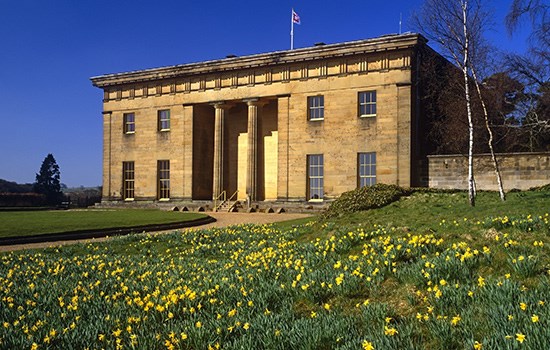
Plan Your Visit
Prepare to be enchanted by Belsay’s Grecian architecture, medieval castle, and 30 acres of outstanding gardens.
-
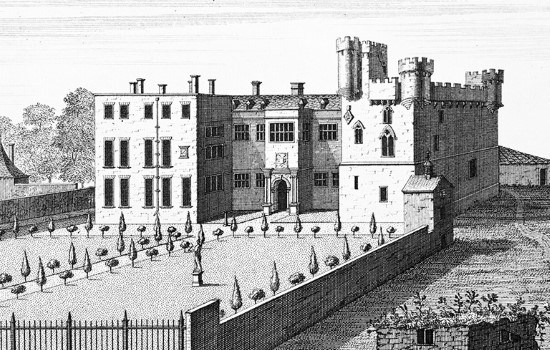
History of Belsay
Read the history of the Belsay estate from its medieval castle to its 19th-century hall.
-
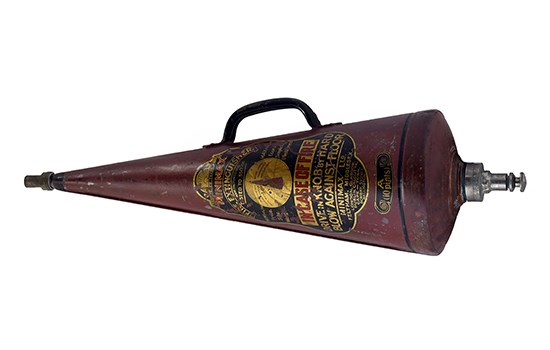
COLLECTION HIGHLIGHTS
Explore Belsay’s collection highlights, an eclectic mix that ranges from skirting boards to architraves and from wallpaper to toilets, as well as a few personal items.
-
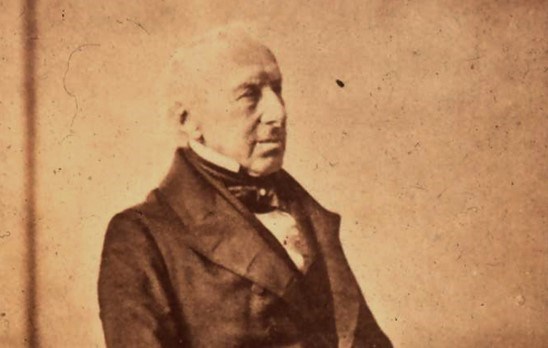
Monck’s Grand Tour Diaries
We delve into Charles Monck’s travel diaries to learn how his Grand Tour influenced the design of Belsay Estate.

